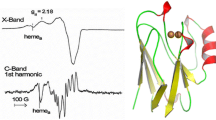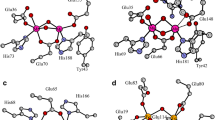Abstract
Rat liver arginase contains a dinuclear Mn2(II,II) center in each subunit having EPR properties similar to those observed in Mn-catalases. The principal physiologic role of arginase is catalyzing the hydrolytic cleavage of l-arginine to produce l-ornithine and urea. Here we demonstrate that arginase catalyzes the disproportionation of hydrogen peroxide by a redox mechanism analogous to Mn-catalases, but at rates that are 10–5 to 10–6 of k cat for the Mn-catalases, and also exhibits peroxidase activity. The dinuclear Mn2(II,II) center is essential for maximal catalase activity, since both the H101N and H126N mutant arginases containing only one Mn(II)/subunit have catalase activities that are <3% of that for the wild-type enzyme. Like the Mn-catalases, the catalase activity of arginase is not inhibited by millimolar concentrations of CN–, the most potent inhibitor of heme catalases, or by EDTA, a chelator of free metal ions. The catalase activity of arginase is not significantly inhibited by Cl– or F–, in contrast to Mn-catalases, while potent inhibitors of the hydrolytic activity are also effective inhibitors of the catalase activity. These results suggest that lower affinity of hydrogen peroxide to the active site of arginase contributes to the lower catalase activity. EPR spectroscopy reveals that potent inhibitors of the hydrolytic reaction, including N ω-hydroxy-l-arginine, l-lysine, and l-valine, decouple the electronic interaction between the Mn2+ ions, most probably by removing a μ-bridging ligand or by increasing the intermanganese separation. The capacity for arginase to deliver a hydroxide ion to hydrolyze the l-arginine substrate is suggested to arise from a "dinuclear effect", wherein the two metal ions contribute more or less equivalently in deprotonation of metal-bound water molecule. Structure-reactivity analyses of these reactions will provide insights into the factors that control redox versus hydrolytic function in dimanganese clusters.
Similar content being viewed by others
Author information
Authors and Affiliations
Additional information
Received: 18 November 1996 / Accepted: 7 April 1997
Rights and permissions
About this article
Cite this article
Sossong Jr., T., Khangulov, S., Cavalli, R. et al. Catalysis on dinuclear Mn(II) centers: hydrolytic and redox activities of rat liver arginase. JBIC 2, 433–443 (1997). https://doi.org/10.1007/s007750050154
Issue Date:
DOI: https://doi.org/10.1007/s007750050154




